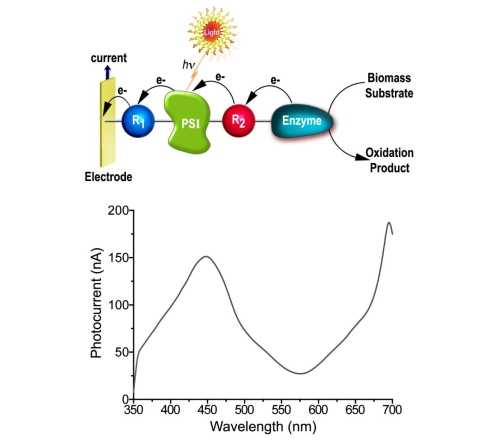
A new paradigm for the development of photo-bioelectrochemical cells has been reported in the journal Nature Energy by researchers from The Hebrew University of Jerusalem, in Israel, and the University of Bochum, in Germany.
The design of photo-bioelectrochemical cells based on native photosynthetic reaction is attracting substantial recent interest as a means for the conversion of solar light energy into electrical power.
In the natural photosynthetic apparatus, photosynthetic reaction is coupled to biocatalytic transformations leading to CO2 fixation and O2 evolution. Although significant progress has been achieved in the integration of native photosystems with electrodes for light-to-electrical energy conversion, the conjugation of the photosystems to enzymes to yield photo-bioelectrocatalytic solar cells remains a challenge.
Now, researchers report on the construction of photo-bioelectrochemical cells using the native photosynthetic reaction and the enzymes glucose oxidase or glucose dehydrogenase. The system consists of modified integrated electrodes that include the natural photosynthetic reaction center, known as photosystem I, conjugated to the enzymes glucose oxidase or glucose dehydrogenase. The native proteins are electrically wired by means of chemical electron transfer mediators. Photoirradiation of the electrodes leads to the generation of electrical power, while oxidizing the glucose substrate acting as a fuel.
The system provides a model to harness the native photosynthetic apparatus for the conversion of solar light energy into electrical power, using biomass substrates as fuels. In contrast to numerous bioelectrochemical systems using electrical power to oxidize glucose, the present study introduces the implementation of the native photosystem to produce electrical power using light as the energy source.
The novel photo-bioelectrochemical cells point to a new method to photonically drive biocatalytic fuel cells while generating electrical power from solar energy.
Prof. Itamar Willner, at the Hebrew University’s Institute of Chemistry, said: “The study results provide a general approach to assemble photo-bioelectrochemical solar cells with wide implications for solar energy conversion, bioelectrocatalysis and sensing.”
The research was headed at the Hebrew University by Prof. Itamar Willner, Institute of Chemistry and Minerva Center for Biohybrid Complex Systems, in collaboration with Prof. Rachel Nechushtai, Alexander Silberman Institute of Life Sciences and Minerva Center for Biohybrid Complex Systems; and at Ruhr-Universität Bochum, by Prof. Wolfgang Schuhmann, Analytical Chemistry, Center for Electrochemical Sciences (CES).
CITATION: Assembly of photo-bioelectrochemical cells using photosystem I-functionalized electrodes. Ariel Efrati, Chun-Hua Lu, Dorit Michaeli, Rachel Nechushtai, Sabine Alsoub, Wolfgang Schuhmann & Itamar Willner. Nature Energy Article number: 15021 (2016). doi:10.1038/nenergy.2015.21. http://www.nature.com/articles/nenergy201521
The Hebrew University of Jerusalem is Israel’s leading academic and research institution, producing one-third of all civilian research in Israel.
Source
Hebrew University of Jerusalem, press release, 2016-01-19.
Supplier
Alexander Silberman Institute of Life Sciences
Hebrew University of Jerusalem
Minerva Center for Biohybrid Complex Systems
Nature Energy Journal
Ruhr-Universität Bochum
Share
Renewable Carbon News – Daily Newsletter
Subscribe to our daily email newsletter – the world's leading newsletter on renewable materials and chemicals









